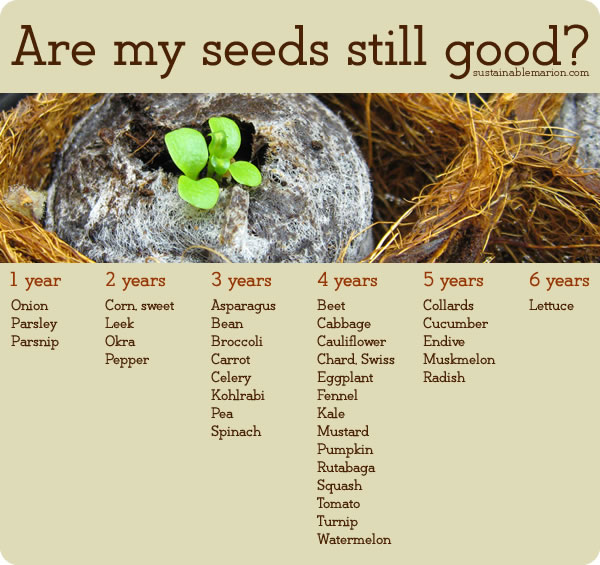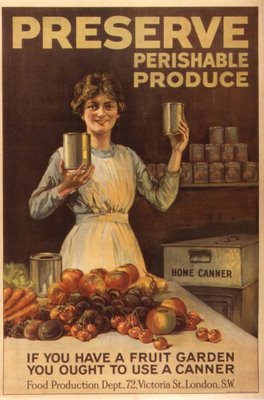Posts
January 3, 2015 9:08 am
Hiya friends! I know it’s been a good, long while since I last posted. I don’t even remember what happened back in 2013 after that canning post, but I know for sure that 2014 was kind of a waste gardening-wise. There was a garden, but we only grew about half our usual because we had a baby due in August (prime tomato canning season) and I didn’t want to be fat and pregnant and awkward out there trying to weed and such. As it was, by October we had a monster amount of tomatoes to pick before we ripped everything out.

What to do with a new baby and a garden that needs tamed. Multi-tasking for the win!
So now that the new year is here, it’s time to start planning the upcoming garden. Charts get made, seeds get ordered, and our rigged grow box gets the cobwebs dusted off and ready for use for seedlings.

Our planning process goes a bit like this:
- Take inventory of seeds to see what we have, what we might need to order, etc
- Look at last year’s planning chart to see what we planted where (our garden is divided into quarters, and each year we rotate the whole layout so nothing gets planted in the same place as the previous year)
- Map out this year’s garden with our “must plant” items.
- Fill in the empty/free spaces with our “like to try” plants.
- Order seeds.
This year we had to order new brandywine seeds, as well as a paste tomato. The San Marzano tomato seeds I purchased at Menards ended up being… well, tiny. That’s what I’m picking in the photo above. There was NO WAY I was going to try to peel all those tiny tomatoes to make sauce. Nope. Not going to happen. New(ish) this year, we’re going to try brussel sprouts. I attempted to grow them from seed last year and then I let them die in the grow box in the basement. Oops. So we’ll try them again this year. Also, tomatillos, because I LOVE roasted tomatillo salsa. That with some homemade corn tortillas… Mmmmm mmmmm!
What are your gardening plans this year? Are you trying anything new? Do you have a favorite standby that you plant every year?
July 10, 2013 4:28 pm
 Berries, berries, and more berries! Last week a friend of mine kindly let me raid her blueberry bush, and my parents let me pick some of their red raspberries (mine in the garden are still ripening but aren’t very great). What’s a girl to do with a ridiculous amount of berries? Can them up!
Berries, berries, and more berries! Last week a friend of mine kindly let me raid her blueberry bush, and my parents let me pick some of their red raspberries (mine in the garden are still ripening but aren’t very great). What’s a girl to do with a ridiculous amount of berries? Can them up!
So far I have blueberry basil jam, blueberry muffin jam, and what was supposed to be a blueberry marmalade but it never set up and is more like a sauce (a delicious, tasty sauce that is heaven on pancakes). I sliced and dehydrated a few trays of blueberries in my dehydrator, and I have a 1-gallon zip lock bag in the freezer full of blueberries still to use. I ended up with about 7 cups of raspberries from my parents’ place, so those were cooked down with some sugar and some lemon juice and canned into 8oz jelly jars as raspberry sauce for ice cream.
Not too shabby for the first preserves of the season!
This will probably end up being the only ‘sweets’ I can up this season, at least until apples are in season in the fall. I’m the only ‘jam fan’ in the house and while I’d love to make ALL the jam combinations (my mom makes a kiwi jam that is SO GOOD), I just wouldn’t eat it all up by next year’s canning season. And I can’t lie – I’m not a huge fan of gifting my canned goods. Mostly because those jars aren’t free, and I very rarely ever have anyone remember to give me back the jar so I can re-use it when they’re done with the jam.
July 8, 2013 1:55 pm
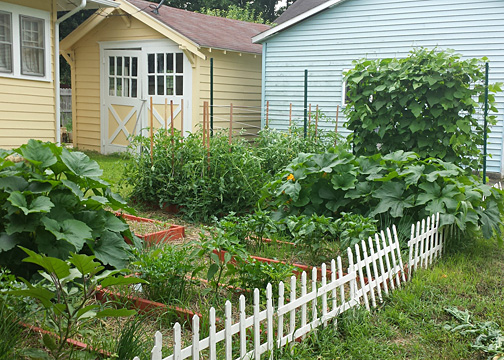 Is everyone else tired of the rain? I mean, I’m not complaining… much. Check out our garden! Clearly the rain has been fantastic for the veggies! Just a month ago the beans were barely climbing the trellis, the zucchini and squash were a fraction of their current size, and everything just looked so small. Now look at it! Organic gardening FOR THE WIN!
Is everyone else tired of the rain? I mean, I’m not complaining… much. Check out our garden! Clearly the rain has been fantastic for the veggies! Just a month ago the beans were barely climbing the trellis, the zucchini and squash were a fraction of their current size, and everything just looked so small. Now look at it! Organic gardening FOR THE WIN!
Gardening is a lot of waiting. You wait until the frost date to plant. Then you wait for the seeds to germinate. Then you baby them with water and weed a bit while you wait for everything to grow. Wait, wait, wait. So much waiting, but when things finally start producing delicious, tasty home-grown food WATCH OUT. You’ll have more on your hands than you know what to do with.
I’ve been severely slacking on the updates, but here’s what’s going in the garden currently: We had our first harvest a few weeks ago with the bed full of radishes. And, of course, I forgot to tally up the total weight of the harvest. Last week we picked about 6 zucchini totaling in around 1.9 lbs with more zucchini on the way! Already I’m feeling a bit ‘done’ with zucchini, so I’m going to have to start getting creative with how I work it into our meals. I found 3, maybe 4 little bitty acorn squashes growing, with plenty of blooms for more. Peppers, beans, and eggplants are all blooming, and we have quite the haul of green tomatoes with more blooms coming. Oh, and cucumbers are blooming like crazy with lots of teeny tiny cukes!
We planted Sugar Baby watermelons in the box between the zucchini and tomatoes, but you can’t tell because they’re taking their sweet time growing. I swear those things sat in the box with their two “true” leaves for a month before I saw any more growth. I’ve never tried growing melons before, so we’ll see if we end up with any this year. If not then I might just have to find something else to plant next year in that spot instead.
I’ve added a new page for the garden harvest tally, so you can see, too, how much food we’ve raised from our little city lot!
April 15, 2013 4:14 pm
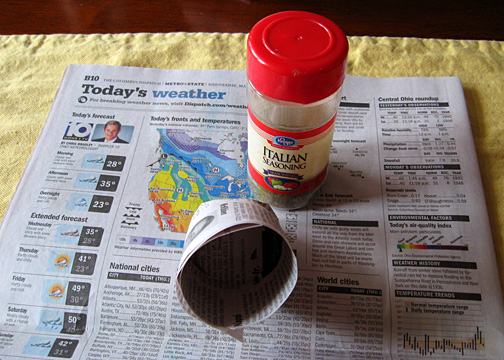
For a while now I’ve wanted to make my own newspaper seedling pots, and I wanted one of those wooden pot makers because I thought I had to have one to do it. And then I realized that I don’t need some silly single-purpose item sitting around my house, because I could make the little pots all on my own with what I have on hand: a plastic spice jar. It’s not as ‘pretty’, but it’s functional and does the trick!
What you’ll need: a spice jar, some newspaper, and a pair of scissors. That’s it! Easy peasy, right?
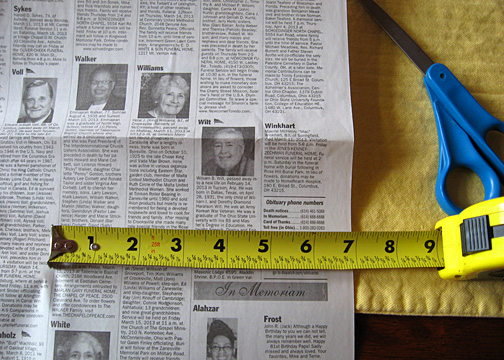
You’ll want to cut your newspaper into strips about 3.5-4″ wide. The obituaries section of the Dispatch happened to be the first page I grabbed from my garden newspaper pile, and since it already has lines printed between the colums I just cut the paper into not-exact 3rds, with two columns on each strip. The middle section, for example, is a little over 3 inches, but the last two columns are a little under 4″. It doesn’t have to be perfect, it just can’t be too narrow, since you’ll want overhanging paper for the bottom of your pot.
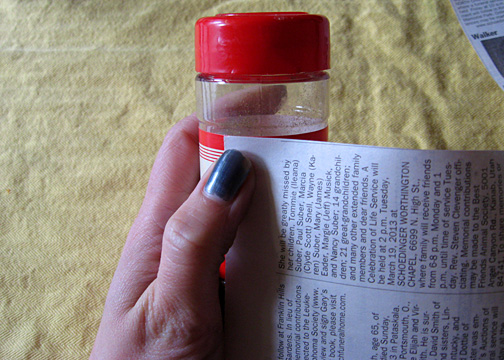
Find a spot on your spice jar that leaves paper hanging off the end, and then wrap the paper around the jar a few times until you get to the end of the paper strip.
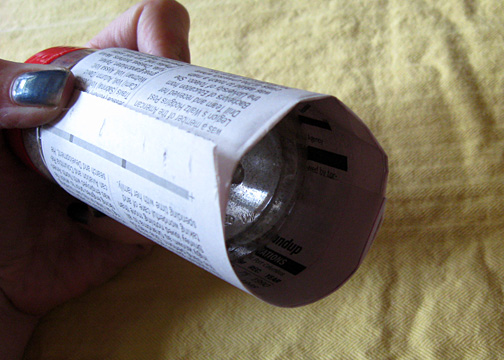
See what I mean about overhanging the paper? From here you’re going to fold those ends down.
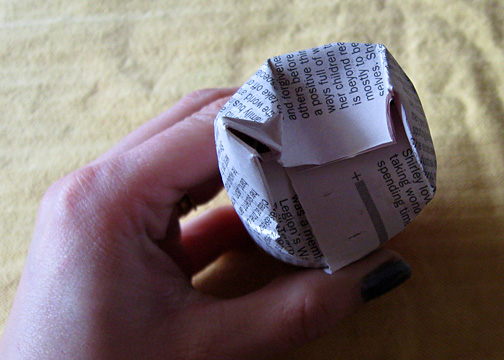
I first fold down the area where the wrapped paper ends on the outside, then I move opposite that spot and fold it down on top of it. This helps keep the paper from unrolling, since you’re securing the outside edge first.
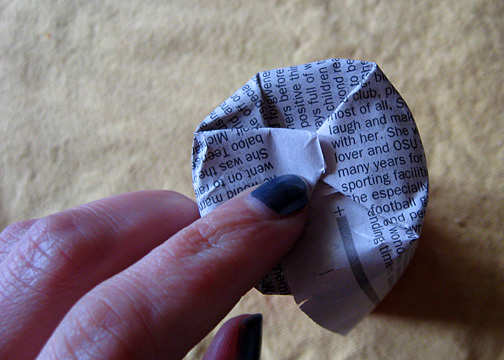
Then fold the last two areas down, flip the whole thing over and tamp the spice jar down a bit to help crease and secure the newspaper. The ends won’t stay folded down, but we’ll fix that in a bit.
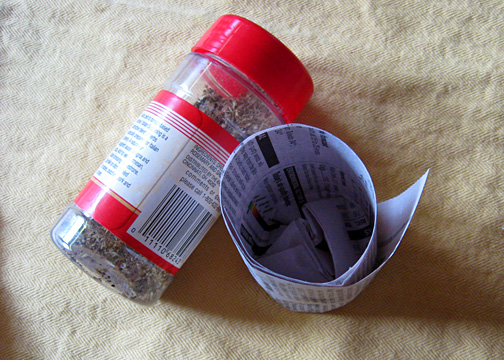
Gently remove the spice jar from your newspaper, and ta-dah! Newspaper seedling pot! If it won’t stand because the ends keep flipping out, you can do a couple of things to fix it. The obvious solution is tape, but since these pots are plant-able and will naturally compost/degrade you don’t want to use something that isn’t biodegradable. What I like to do is push the ends up into the center of the pot, and then readjust them so there’s not a hole for soil to escape in them. Then it should sit nicely.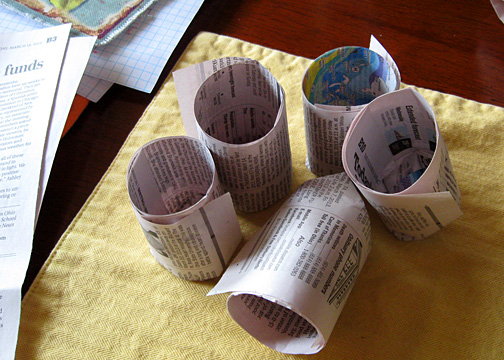 From here, carefully fill the pots with your soil of choice and plant your seeds! The newspaper will naturally break down over time, but they shouldn’t break down before you get a chance to plant your seedlings outside. And if you happen to need bigger pots as your seedlings grow larger, cut a larger piece of paper and use a drinking glass or some other, wider item to make your pots using the same method.
From here, carefully fill the pots with your soil of choice and plant your seeds! The newspaper will naturally break down over time, but they shouldn’t break down before you get a chance to plant your seedlings outside. And if you happen to need bigger pots as your seedlings grow larger, cut a larger piece of paper and use a drinking glass or some other, wider item to make your pots using the same method.
April 13, 2013 11:48 am

Lots of great things going on for Earth Day! Go check out the Facebook Event for more details on all the neat things happening in town!
April 4, 2013 8:38 am
We all get sick from time to time, and sometimes we require medications to get better. But what do you do with those meds once they’ve expired/you no longer need them?
Problem solved: you drop them off at the local Medication Disposal Day on April 27th! You can head over to the Marion County building (over on W. Center St.) from 10am-2pm and drop off any pills, liquids, or creams you no longer need. Our local law enforcement officers will make sure your medications are disposed of in a safe, eco-friendly manner at no cost. And any prescription containers will be recycled with your personal information protected.
Why should you dispose of your meds this April instead of flushing or tossing them in the trash? Because the medications we take are showing up in our waterways – both from natural excretion and from improper disposal. According to the Scientific American:
“A nationwide study conducted by the U.S. Geological Survey in 1999 and 2000 found low levels of pharmaceuticals—including antibiotics, hormones, contraceptives and steroids—in 80 percent of the rivers and streams sampled.”
I don’t know about you, but I’d prefer my drinking water without steroids!
Get more information/stay up-to-date on this event by checking out Marion County Recycling & Litter Prevention on Facebook.
April 2, 2013 11:47 am
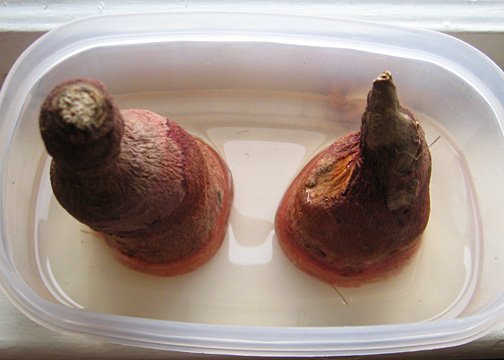
A few months ago I ran across this post on how to grow your own sweet potatoes. Everything looked easy enough, and store bought sweet potatoes aren’t too expensive, so I bookmarked the site for use later.
About a month or so ago I found myself in Columbus at Whole Foods, so I decided to pick up an organic sweet potato or two (since the post did, after all, mention that they should be organic). I came home with two beautiful sweet potatoes, and I was just sure that this was going to work and that by the end of the garden season I’d have a nice pile of the home grown variety.
I’m here to tell you that what you see above? That’s the month-long progress my potatoes have made. Which is to say: none. They’ve shriveled up a bit, and look like they’re on their way to Decompositionville. But there’s not a single slip to be found on them. I think it’s safe to say this little experiment of mine has failed. I’m not sure if I tucked the container in the grow box with the heat mat if that would help. Maybe our house is just too cold for a sweet potato?
The irony here is that my non-organic baking potatoes from Meijer are sprouting all on their own without my intervention. So perhaps, instead of sweet potatoes, I’ll just build myself a potato tower out of wire and we’ll grow regular potatoes instead.
March 31, 2013 11:18 am

Well, it’s Easter Sunday, which means a lot of people out there have probably dyed eggs for the munchkins to hunt, and you’ll now be eating eggs until you’re sick of them for the rest of the week because aforementioned munchkins won’t eat them. At least that’s how it worked in my house as a kid.
Now is a good time to start saving those egg shells for your garden! I rinse mine to get any leftover egg white out of the shell, and then I set them aside to dry before I throw them in an re-purposed salsa jar and give them a shake to crush them up a bit. Then they’re popped into another, bigger re-purposed salsa jar to collect until I have enough for the upcoming year’s garden.
Use your shells when you plant your tomatoes and peppers (and eggplant, if you grow it!)- just sprinkle some into the hole before you set in your plant. These plants need calcium and a lack of it can cause what’s known as blossom end rot (BER). And let me tell you, BER can make for some really disappointing harvests. We’ve had years where we’ve had more bad tomatoes than good, and when you’ve spent hours and hours tending your plants and weeding a bad harvest can be heartbreaking. Planting shells with your plants gives them a calcium source right where they need it, and as the shells break down your plants will suck up calcium for use in producing fruit.
If you have a problem with slugs, you can use your eggshells to sprinkle around your plants to keep the pests away. The sharp edges of the shells act as a deterrent to them since they don’t like crawling over sharp or jagged things.
I’ve heard, but not tried yet (we don’t boil eggs often), that you can take the water you boiled your eggs in and use it to water your calcium-loving plants. Obviously you need to let the water cool so you’re not pouring boiling hot water on them! Boiling eggs is supposed to leave you with water fortified with calcium, so rather than dump that water down the drain why not feed your plants?
And, of course, you can always just throw them in the compost bin to break down with all the other organic scraps, giving you a well-rounded fertilizer for your plants.
Want more ideas on how to use those eggshells instead of throwing them out? Check out The Prairie Homestead’s list of 30 things you can do with egg shells (some of which even this Earth lover won’t attempt…Eggshell membrane bandage? No thanks!)
March 18, 2013 11:52 am

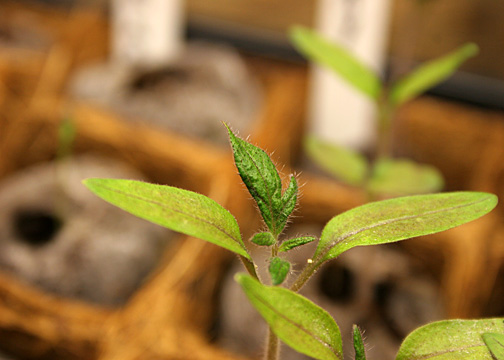
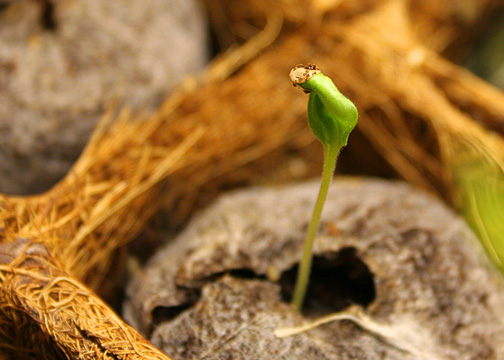
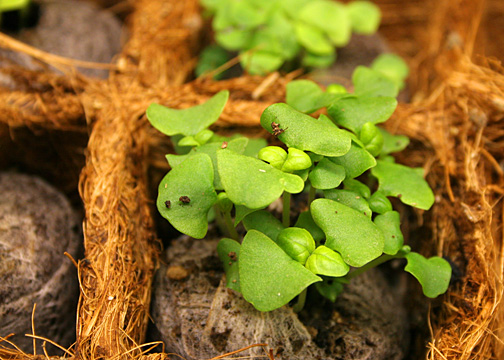
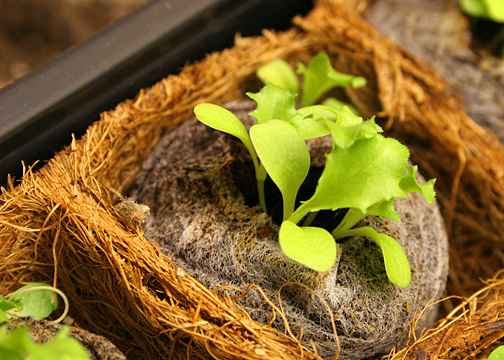
A month ago (February 16th) these coconut pots were just empty little plantable shells. Now they’re full of life! Everything needs thinned out – I have multiple tomatoes growing in the same pot, and the same goes for my peppers. The tomatoes are beginning to show their ‘true’ leaves, as are the peppers though they’re still too tiny to get a good picture of. The basil is also starting to show ‘true’ leaves and is also starting to get a bit taller after spending the last few weeks hugging the dirt a bit. My eggplant has finally germinated and sprouted (and, of course, it sprouts after I already acquired new seeds to plant out of fear that my seeds were past their expiration). And the endive… well, I’m not quite sure what to do with it. I’ve never had endive before, nor have I grown it, so I guess I should do some research and figure out what to do now.
Not sure how you’d get your seedlings started indoors? Here’s my not-at-all-fancy set-up:
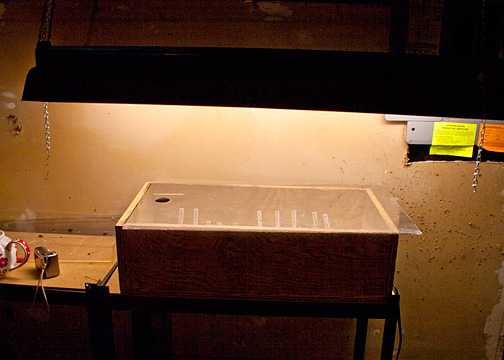
There are multiple ways you can get your seedlings started and some of them are ridiculously priced (and I don’t have $400 to blow just to grow my own veggies), but what works for me is the above. Seedlings need a lot of light, which is something we don’t have enough of this time of year. The fluorescent light provides the light needed for the seedlings, and having it adjustable on chain means you can raise and lower it as-needed. You’ll want your light just above your seedling tray so your seeds don’t get too tall/stringy trying to reach for the light. As the seedlings grow taller you’ll raise the light a bit higher.
Seedlings also need warmth to germinate, which is hard to come by in a cold basement (or, you know, in Ohio in the winter). That’s where a heat mat comes in handy. On the right side of my set-up you can see a cord hanging out the side – that’s where my heat mat comes out of the box to be plugged in. The wood box and plexi-glass top itself isn’t necessary, but my dad made it for me so it’s what I use. You can use those plastic set-ups at the store that are a black tray and a clear plastic top that basically creates a warm, humid greenhouse for your seedlings.
In all, you can put together your own seedling set-up for not a whole lot of money – even if you buy everything new. You can sometimes find the fluorescent lights at garage sales on the cheap, but I’ve priced out new ones for a future second set-up and Lowes has a 48″ plug-in light for $17.98, plus your cost of bulbs and chain to hang it. The grow mat/greenhouse tray I think was about $25ish? And once you’ve made the investment you’ll have equipment that will last you year after year to start plenty of seedlings for your garden. The seedlings we grew the first year paid us back for the investment when you consider the cost of buying garden plants from a nursery or garden center.
March 3, 2013 9:46 pm
Did you know that seeds have a ‘shelf life’? I didn’t know that for the longest time, and for a while just figured that my veggie seeds weren’t germinating because I had done something wrong. As it turns out, the shelf life of my seeds were well past expired (and, okay, I probably didn’t store them in ‘ideal’ conditions, either).
How do you know if your seeds are still okay to plant? If you’ve purchased those little seed packets from the store (Lowes, Walmart, etc), take a look at the back. You should be able to find what year the seeds were packed for. 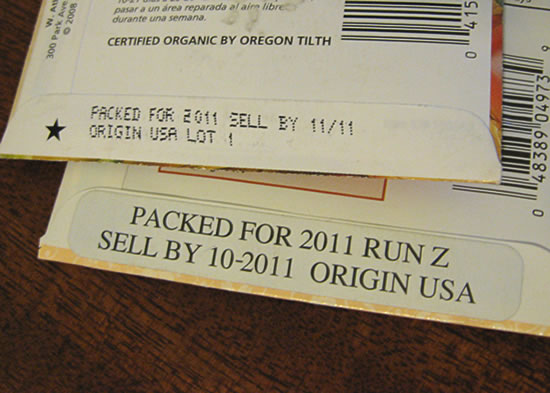
Now it gets a little tricky here because a seed packed for a certain date (2011 for my Hillbilly tomato and California Wonder bell peppers) doesn’t necessarily mean that my seeds are only 2-3 years old. Who knows how long those seeds sat around before they were packaged for sale? For all the consumer knows, those seeds could have sat around for quite a while. If you’re having trouble with your seeds not doing anything, this date is a decent clue into how old your seeds are.
If you’re a smartypants you probably save seeds from your garden each year, giving you a free supply of seeds for next year’s garden. When you’re tucking away your seeds to store for next year write down the year those seeds were harvested. That way, if you decide to take a year or two off from growing, let’s say, cucumbers because you ended up sick of them after a bumper crop, you can come back to your seed stash two years later and know exactly what year you saved those seeds and if they’re still viable.
Some seeds last longer than others, so here’s a handy little chart I threw together (based on information found from the Iowa State University Extension online) to help keep this seed shelf life business straight:
